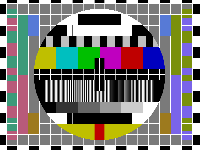Criticism of television
From The Art and Popular Culture Encyclopedia
| Revision as of 19:32, 8 September 2014 Jahsonic (Talk | contribs) ← Previous diff |
Revision as of 08:58, 23 December 2014 Jahsonic (Talk | contribs) Next diff → |
||
| Line 1: | Line 1: | ||
| - | [[Image:A test pattern of the type produced by the PM5544 generator..png|thumb|right|200px|[[Television]] [[testcard]]]] | + | [[Image:A test pattern of the type produced by the PM5544 generator..png|thumb|right|200px|This page '''{{PAGENAME}}''' is part of the ''[[television]]'' series.<br> <small>Illustration: [[Television]] [[testcard]]</small>]] |
| {| class="toccolours" style="float: left; margin-left: 1em; margin-right: 2em; font-size: 85%; background:#c6dbf7; color:black; width:30em; max-width: 40%;" cellspacing="5" | {| class="toccolours" style="float: left; margin-left: 1em; margin-right: 2em; font-size: 85%; background:#c6dbf7; color:black; width:30em; max-width: 40%;" cellspacing="5" | ||
| | style="text-align: left;" | | | style="text-align: left;" | | ||
Revision as of 08:58, 23 December 2014

Illustration: Television testcard
|
“The Revolution Will Not Be Televised” --Gil Scott-Heron, 1970 "Television, the Drug of the Nation" --The Disposable Heroes of Hiphoprisy, 1992 |
|
Related e |
|
Featured: |
As television became the increasingly dominant form of mass communication, critics complained of how poorly the medium lived up to its promise of serving the public interest, most notably in Newton N. Minow's 1961 speech describing the "vast wasteland" that was television programming of the day. Television was characterized as the "boob tube", a mindless occupation and time filler.
Since its invention, television has been accused of testing the limits of propriety in society. This is in contrast to author Milton Shulman’s example of television in the 1960s, where “TV cartoons showed cows without udders and not even a pause was pregnant,” and on-air vulgarity was much more frowned upon. Shulman writes that even by the 1970s, television was shaping the ideas of propriety and appropriateness in the countries the medium blanketed. He asserts that, as a particularly “pervasive and ubiquitous” medium, the TV can create a comfortable familiarity with and acceptance of language and behavior once deemed socially unacceptable. Television, as well as influencing its viewers, evokes an imitative response from other competing media as they struggle to keep pace and retain viewer- or readership.
Complaints about the social influence of television can also be heard from the justice system as investigators and prosecutors alike decry what they refer to as “the CSI Syndrome.” They complain that, because of the popularity and considerable viewership of CSI and its spinoffs, juries today expect to be “dazzled,” and will acquit criminals of charges unless presented with impressive physical evidence, even when motive, testimony, and lack of alibi are presented by the prosecution.
Contents |
Psychological negative effect
The basal ganglia portion of the brain becomes very active when a person plays video games and watches TV. And the body releases a chemical called dopamine. Ritalin (and cocaine) also works on the basal ganglia of the brain and increase dopamine. More dopamine is released; the less neurotransmitter is available to do anything else.
Alleged dangers
Legislators, scientists and parents are debating the effects of television violence on viewers, particularly youth. Fifty years of research on the impact of television on children's emotional and social development have not ended this debate (see Bushman & Anderson 2001; Savage, 2008).
Bushman & Anderson (2001) among others have claimed that the evidence clearly supports a causal relationship between media violence and societal violence. However other authors (Olson, 2004; Savage, 2008) note significant methodological problems with the literature and mismatch between increasing media violence and decreasing crime rates in the United States.
A 2002 article in Scientific American suggested that compulsive television watching, television addiction, was no different from any other addiction, a finding backed up by reports of withdrawal symptoms among families forced by circumstance to cease watching. However this view has not yet received widespread acceptance among all scholars, and "television addiction" is not a diagnoseable condition according to the Diagnostic and Statistical Manual -IV -TR.
As an example of one study, a longitudinal study in New Zealand involving 1000 people (from childhood to 26 years of age) demonstrated that "television viewing in childhood and adolescence is associated with poor educational achievement by 12 years of age". A study published in the Journal of Sexuality Research and Social Policy concluded that parental television involvement was associated with greater body satisfaction among adolescent girls, less sexual experience amongst both male and female adolescents, and that parental television involvement may influence self-esteem and body image, in part by increasing parent-child closeness. Numerous studies have been done on the relationship between TV viewing and school grades. However numerous other studies have found little or no effect for television viewing on viewers (see Freedman, 2002).
Propaganda delivery
Audiovisual media, including television, is the second most effective means of communication available to the psychological operator. Effectiveness is based on seeing and hearing the persuasive message. These media are an excellent means of transmitting persuasive messages and eliciting a high degree of recall.
Propaganda can exist on news, current affairs or talk show segments, as advertising or public-service announce "spots" or as long-running advertorials.
See also

